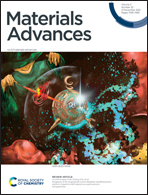Design of non-transition-metal-doped nanoribbon catalysis to achieve efficient nitrogen fixation†
Abstract
The high percentage of N2 in the air can provide an abundant nitrogen source for the ammonia industry. However, the nitrogen fixation process still faces great challenges due to the stable nitrogen–nitrogen triple bonds. Recently, single-atom catalysts (SACs) have arguably become the most promising frontier in the synthetic ammonia industry due to their high activity, selectivity and stability. In particular, metal-free catalysis has attracted great attention due to its low-cost and environmentally friendly features. Herein, we investigate a series of nitrogen-reduction reaction (NRR) electrocatalysts as graphene nanoribbons (GNRs) embedded with 16 kinds of non-transition metal single-atom catalysts (non-TMSACs) using density functional theory (DFT) computations. The stability of this system is first confirmed by AIMD simulations and formation energies. Among all the candidates, Si anchored on the GNR system achieves a limiting potential as low as −0.45 V and the binding energy for NNH also serves as a good descriptor for the onset potential. The electronic structure reveals that this design satisfies an “acceptance–donation” interaction scenario, which is also confirmed by the crystal orbital Hamilton population (COHP) and the spatial charge distribution. This study not only proposes an effective catalysis approach for the NRR, but also emphasizes the origin of electronic structures, which may provide guidance for future NRR catalyst designs.



 Please wait while we load your content...
Please wait while we load your content...